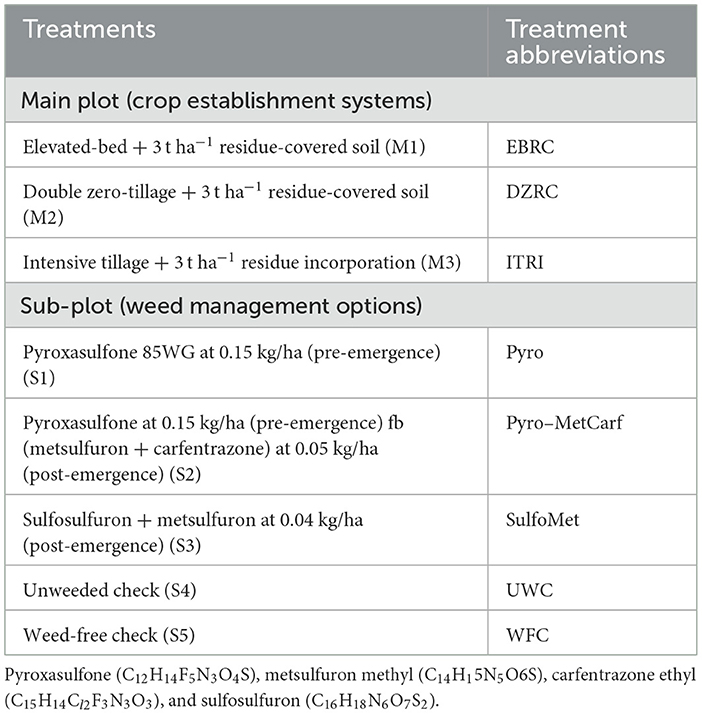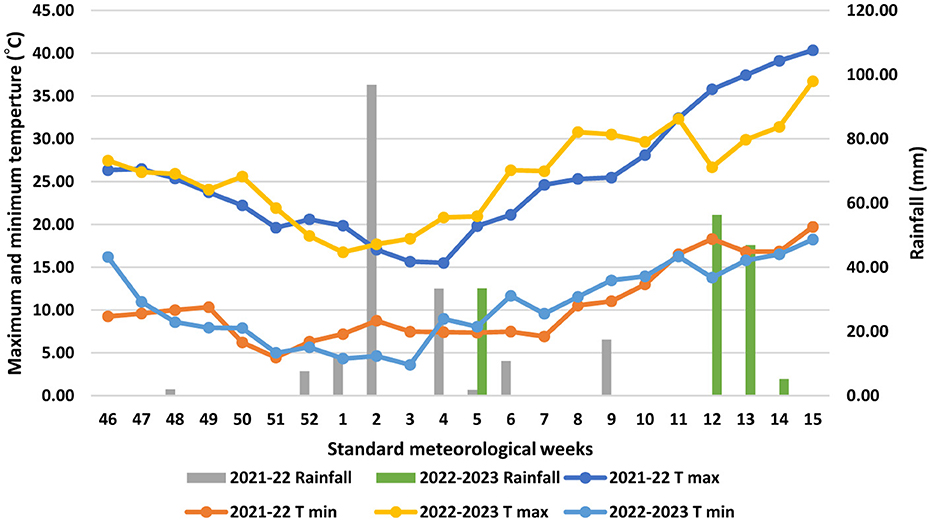- 1Division of Agronomy, ICAR-Indian Agricultural Research Institute, New Delhi, India
- 2Division of Microbiology, Indian Council of Agricultural Research-Indian Agricultural Research Institute, New Delhi, India
- 3Indian Institute of Maize Research, Indian Council of Agricultural Research-Indian Institute of Maize Research, Ludhiana, India
Transitioning to maize–wheat system (MWS) in conjunction with conservation agriculture has emerged as viable option to tackle the multiple challenges of yield stagnation, environmental threats, and resource depletion under conventional puddled-transplanted rice–wheat rotation in Indo-Gangetic Plains (IGP). However, efficient weed management and crop establishment strategies are critical to sustaining crop and resource productivity of MWS. To develop weed management options under diverse tillage systems, three crop establishment methods viz. elevated-bed + residue (EBRC), double zero-tillage + residue (DZRC), and conventional intensive tillage + residue (ITRI) in main plots and five weed management approaches, namely, pyroxasulfone (pyro; Pre-Emergence), Pyro (PE) fb metsulfuron + carfentrazone (MetCarf; Post-Emergence), sulfosulfuron + metsulfuron (SulfoMet; Post-Emergence), unweeded check (UWC), and weed-free check (WFC), were compared in a split-plot design. Reduced weed population and dry matter accumulation were noted with EBRC, relative to DZRC and ITRI. The growth and productivity of wheat remained higher in EBRC compared to DZRC, but it was at par to ITRI. Among diverse weed management options, dual-stage spray of Pyro–MetCarf substantially reduced the densities of sedges (36.7%), and narrow-leaved (64.1%) and broad-leaved (58.9%) weeds, compared to the UWC. Significantly higher weed control efficiency (80.3%), weed control index (79.4%), and lowest weed index were observed under Pyro–MetCarf combination compared to other herbicidal treatments. The same treatment also enhanced the wheat growth and yield (24.6%) over UWC and other herbicide applications. Conclusively, dual-stage herbicidal application of Pyro–MetCarf coupled with EBRC enhances wheat productivity by reducing the infestation of weeds substantially in IGP. The findings suggest that integrating dual-stage herbicidal application with EBRC offers a scalable and resource-efficient strategy for policymakers and practitioners for the wheat belt of IGP.
1 Introduction
Wheat [Triticum aestivum (L.) emend Fiori & Paol] is the leading staple crop of the world grown over 215.9 mha area with production of 790.8 million tons and productivity of 3.54 t ha−1 (USDA, FAS, 2024). Globally, wheat is consumed by ~2.5 billion people across ~90 countries (CGIAR, 2020), with annual trade volumes of 207.3 million tons (USDA, 2024) and an estimated global trade value of approximately US $59 billion (IMF, 2024). In India, wheat accounts for 36% of its total foodgrain production, contributing 20% to the nation's protein intake and 19% to calorie consumption (Ramadas et al., 2019). Covering 31.4 million hectares, the largest wheat acreage globally, India produces ~110.5 million tons of wheat, with a productivity of 3.52 t ha−1 (Annual Report, 2023-24, DFAFW, GOI).
Majority of wheat in South Asia is cultivated under cereal–cereal (after rice, maize, sorghum or pearl millet) rotation, with rice–wheat system (RWS) being the principal production system, covering more than one-third of the wheat acreage (Dhanda et al., 2022). Intensive tillage practices in prolonged RWS resulted in large-scale poor soil physical conditions, breaking down aggregates and creating hard pans (Kumari et al., 2011; Mondal et al., 2019), and hastening the degradation of organic matter (Lal, 2015; Roper et al., 2013; Das et al., 2014), in addition to environmental and water-related challenges. Present intensive-tillage practices transform soil into a source of atmospheric pollutants rather than a sink, threatening ecological and economic sustainability (Busari et al., 2015). In addition, the conventional crop establishment systems necessitate more labor and higher energy inputs and escalate production costs (Das et al., 2020; Kaur et al., 2020, 2023).
Diversifying the RWS with a more stable maize–wheat system (MWS) is a suggested pathway to address key soil, water, and environmental challenges associated with RWS (Bana et al., 2014; Yin et al., 2018; Venkatesh et al., 2017). Furthermore, conservation agriculture (CA) serves as a vital sustainable strategy for resource conservation, mitigating the adverse effects of climate change and enhancing profitability (Das et al., 2014). This crop establishment system also improves input use efficiency, sustains long-term productivity, and promotes carbon sequestration (Bhattacharyya et al., 2015; Sharma et al., 2012; Sharma, 2021). The CA with system diversification provides multiple benefits, including reducing soil erosion (Page et al., 2013), maintaining soil organic matter (Bhattacharyya et al., 2015; Lal, 2015; Qi et al., 2022), controlling weed growth (Baghel et al., 2020), retaining soil moisture, preventing soil compaction (Mondal et al., 2019), improving soil structure (Mondal et al., 2019; Qi et al., 2022), and enhancing both above- and below-ground biological processes and biodiversity (Ghosh et al., 2019).
Despite various challenges to the productivity, profitability, and sustainability of MWS, weeds remain a major obstacle due to their strong competition with crops for essential resources. Several studies reported differential losses owing to weed infestation in wheat crop ranging from 24.5% to as high as 55.7% (Kumar et al., 2013; Malik and Yadav, 2008; Kaur et al., 2017; Yadav et al., 2018) and nutrient loss due to weeds varies from 30 to 40% (Mundra et al., 2002). The presence of weeds diminishes the photosynthetic efficiency and photosynthate partitioning to the economical parts and thereby lowering sink capacity leading to poor and unstable yields (McKenzie-Gopsill et al., 2020). Critical period for weed control depends on the density, competitiveness, and emergence periodicity of the weed population (Das, 2008; Evans et al., 2003 and Bystro et al., 2012).
However, as tillage operations are enormously reduced in CA, weed infestation can become a prime limiting factor in crop production, particularly during early years of CA adoption (FAO, 2020; Bana et al., 2020). Overcoming these challenges necessitates a comprehensive weed management approach, incorporating zero tillage, soil residue coverage, diverse crop rotations, and the strategic application of herbicides. Being a rapid, more effective, time- and labor-saving option, chemical weed management is the most widely adopted method by the farmers (Nazari et al., 2013; Mehmeti et al., 2018). Despite the availability of numerous herbicides, no single herbicide has proven effective in managing the diverse weed flora present in arable crops. Moreover, the repeated use of a single herbicide, such as isoproturon, over the years has led to the development of herbicide resistance in Phalaris minor (due to target site resistance mutation in psbA gene) and several other grassy weeds in the IGP. Such scenario underscores the urgent need to identify novel herbicide molecules capable of providing season-long effective and sustainable weed control. Studies conducted by earlier researchers in USA, Canada, Australia, South Africa, and India opined that pre-emergence herbicide pyroxasulfone resulted in satisfactory weed control in maize (Odero and Wright, 2013; Kumar et al., 2021) and wheat (Kaur et al., 2019; Kumar and Kaur, 2024). However, there are reports of late-season weed infestation. Therefore, a dual-stage spray strategy of a combination of pre- and post-emergence herbicides application is obligatory for the effective management of multiple weed flora for season-long weed management in wheat.
This holistic approach is essential for mitigating weed interference and minimizing crop yield losses during the transitioning years of conservation agriculture (CA). Nevertheless, comparatively limited research has been conducted to examine the interactive effects of crop establishment methods, such as elevated-bed planting, residue recycling options, and tillage, in combination with strategic herbicide applications. Furthermore, category-wise (narrow leaved weeds, broad-leaved weeds, and sedges) and species-wise insights on weed dynamics under diverse herbicide–tillage–residue–year interactions have not been studied so far. To address this knowledge gap, the present study was undertaken to evaluate the impact of diverse crop establishment systems, residue recycling, and strategic herbicide application options on species-wise and category-wise weed dynamics and crop performance. Moreover, the experimentation also aimed to assess the combined and individual effects of study years, crop establishment systems, and herbicide applications on weed control efficacy, weed index, and crop productivity. We hypothesized that integrating CA-based crop establishment methods with use of dual-stage broad spectrum herbicide use will significantly reduce weed infestation while enhancing wheat productivity in the maize–wheat system, offering a sustainable alternative to conventional practices.
2 Materials and methods
2.1 Experimental sites and treatments
The experiment was conducted at the ICAR-Indian Agricultural Research Institute, New Delhi (28°64′ N latitude, 77°15′ E longitude, and an altitude of 228 meters above mean sea level) under triplicated split-plot design during the winter (rabi) seasons of 2021–22 and 2022–23. The main-plot treatments comprised of different crop establishment systems, while the sub-plot treatments included five weed management strategies (Table 1). The wheat crop was sown following the harvest of the preceding maize crop, maintaining a maize–wheat cropping system consistently applied on the experimental site for the past 5 years. Among the weed management treatments, the unweeded check (UWC) served as a control, allowing natural weed infestation without any intervention. The experimental field featured sandy loam soil (sand 58.6%, silt 22.8%, and clay 18.6%) with moderate water-holding capacity, an even topography, and a well-functioning drainage system. Soil analysis of the upper 150 mm layer revealed low organic carbon content (0.41%), low available nitrogen (221.3 kg ha−1), medium levels of available phosphorus (18 kg ha−1) and potassium (241.1 kg ha−1), and a slightly alkaline reaction (pH 7.8).
The climatic conditions varied significantly during the 2 years of the study period (Figure 1). In the first year, higher rainfall was recorded during the early stages of crop growth, while the later stages experienced relatively lower rainfall. Conversely, in the second year, the rainfall was more pronounced during the later stages of crop ontogeny. Temperature trends also differed between the years, as a sudden rise in temperature was observed during the grain-filling stage of 2021–22, which contrasted with the second year, where temperatures during this critical stage remained fairly stable.
2.2 Crop management practices
Wheat crop was sown in rows spaced 22.5 cm apart during both years of the study. For EBRC treatment, an elevated-bed planter was used (67.5 cm top and 30 cm furrow). Three rows of wheat variety “HD-3226” were sown on each bed keeping a row-to-row spacing of 22.5 cm using 100 kg seed ha−1 to ensure an optimal plant population. Prior to sowing, the seeds were treated with the carbendazim at 2 g kg−1 of seed to prevent fungal infections. The recommended fertilizer application of 150 kg N ha−1, 60 kg P2O5 ha−1, and 40 kg K2O ha−1 was done through urea, di-ammonium phosphate, and muriate of potash, respectively. Full doses of phosphorus and potassium, along with one third dose of the nitrogen, were applied at the time of sowing. The remaining nitrogen was top-dressed in two equal splits, once at the active vegetative stage (40 days after sowing, DAS) and second at the flowering stage (80 DAS). Herbicides were applied at recommended doses at 2 days after sowing as pre-emergence and 25 days after sowing as post-emergence for effective control of weeds.
2.3 Weed dynamics
A quadrat measuring 0.5 m × 0.5 m was thrown randomly at four different locations within each plot for sampling at 40 DAS, and weeds were counted species-wise, and collected and categorized into sedges, and narrow-leaved and broad-leaved weeds, which were later summed up as total number of weeds. After air drying, the categorized weed species were dried in oven at a temperature of 65°C for 48 h to record the dry matter accumulation by different weed flora. Moreover, the different indices of weeds were calculated to evaluate the efficiency of different herbicides. These indices are mentioned as follows:
2.3.1 Weed index (WI)
The weed index (WI) was calculated for quantifying reduction in wheat productivity across studied herbicidal weed management strategies, relative to WFC. To estimate WI, Equation 1 was used (Gill and Vijaykumar, 1969).
where YWF is the wheat productivity (t ha−1) in WFC, and YT is the wheat productivity (t ha−1) in treated plot.
2.3.2 Weed control efficiency
As per Equation 2, weed control efficiency (WCE) was calculated to assess the efficacy of various weed control treatments based on their effect on weed control (Das, 2008):
where WPCis weed population (No. m−2) in UWC plot, and WPT is weed population (No. m−2) in herbicide applied plot.
2.3.3 Weed control index
Weed control index (WCI) was computed as per the Equation 3 to analyze the comparability of the efficacy of various treatments based on dry weight (Das, 2008).
where WDMC is the oven-dried weight of weeds (g m−2) in UWC, and WDMT is the oven-dried weight of weeds (g m−2) in herbicide applied plot.
2.4 Growth and yield parameters
Numerous growth indices, such as leaf area index (LAI), crop growth rate (CGR), relative growth rate (RGR), and net assimilation rate (NAR), were computed using the following standard equations:
2.4.1 Leaf area index (LAI)
The leaf area index (LAI) was measured using a leaf area meter (LI COR-3100) at regular interval in the crop. The leaf area index (LAI) was calculated by dividing total leaf area by land area using the formula given by Watson (1952).
2.4.2 Crop growth rate
The crop growth rate was worked out following the Equation 5 (Watson, 1958).
where W1 and W2 are dry weight (g) of wheat plants at time T1 (0 days) and T2 (40 DAS), respectively. T1 and T2 are the growth stages of wheat; P is land area (m2) occupied by number of tillers under sampling.
2.4.3 Mean relative growth rate [RGR; mg g−1 (dry matter) day−1]
The mean relative growth rate was worked out using the Equation 6 (Blackman, 1919):
where W1 and W2 are plants dry weight (g) at time T1 and T2, respectively. T1 and T2 are wheat growth stages. Ln is natural logarithm.
2.4.4 Mean net assimilation rate [NAR, g m−2 (leaf area) day−1]
Equation 7 was used for computing mean net assimilation rate (Gregory, 1917).
where W1 and W2 are plants dry weight (g) at time T1 and T2, respectively; T1 and T2 are growth stages of crop. Ln is natural logarithm; LA1 and LA2 are the leaf area (m−2) of plants at time T1 and T2, respectively.
Dry matter accumulation (g m−2) in wheat was determined using a destructive sampling technique. Plant samples were collected from 1 m2 area, air-dried for 2–3 days, and then oven-dried at 105°C for 48 h. Yield attributes such as ear length and the number of seeds per ear were recorded manually from 10 randomly selected representative ears per plot in each replication. Grain yield and biological yield (grain + straw) were estimated based on the net plot area (5 m × 4 m) under each treatment, adjusted to moisture contents of 12.5% and 18%, respectively.
2.5 Statistical analysis
Data on weeds and wheat crop were analyzed by the analysis of variance (ANOVA) technique for a split-plot design using PROC GLM in SAS 9.3 (SAS Institute, Cary, NC). Weed populations were transformed through the square-root transformation method [(x + 0.5)½] before ANOVA to reduce higher variation and for more precision. The species-wise populations of weeds, wheat grain yield, were subjected to Levene's test for homogeneity of variance. The error variances for almost all parameters (i.e., weed and wheat grain yield) were homogeneous over the years, indicating that the uniformity in error variance was significant. The significance of treatment means was appraised using Tukey's honest significant difference (HSD) test at p ≤ 0.05. The genotype + genotype by environment (GGE) biplot analysis was carried out to determine the effects of treatment combinations in controlling the weed population across both the years (Yan and Kang, 2011).
3 Results
3.1 Weed dynamics
The predominant weed flora at the experimental site consisted of two narrow-leaved weed (NLW) species, four broad-leaved weed (BLW) species, and sedges, as detailed in Table 2. A pooled ANOVA over 2 years revealed 3.6% lower Chenopodium murale population in the second year compared to the first year of investigation. However, the densities of other weed species showed no statistically significant variation between the 2 years.
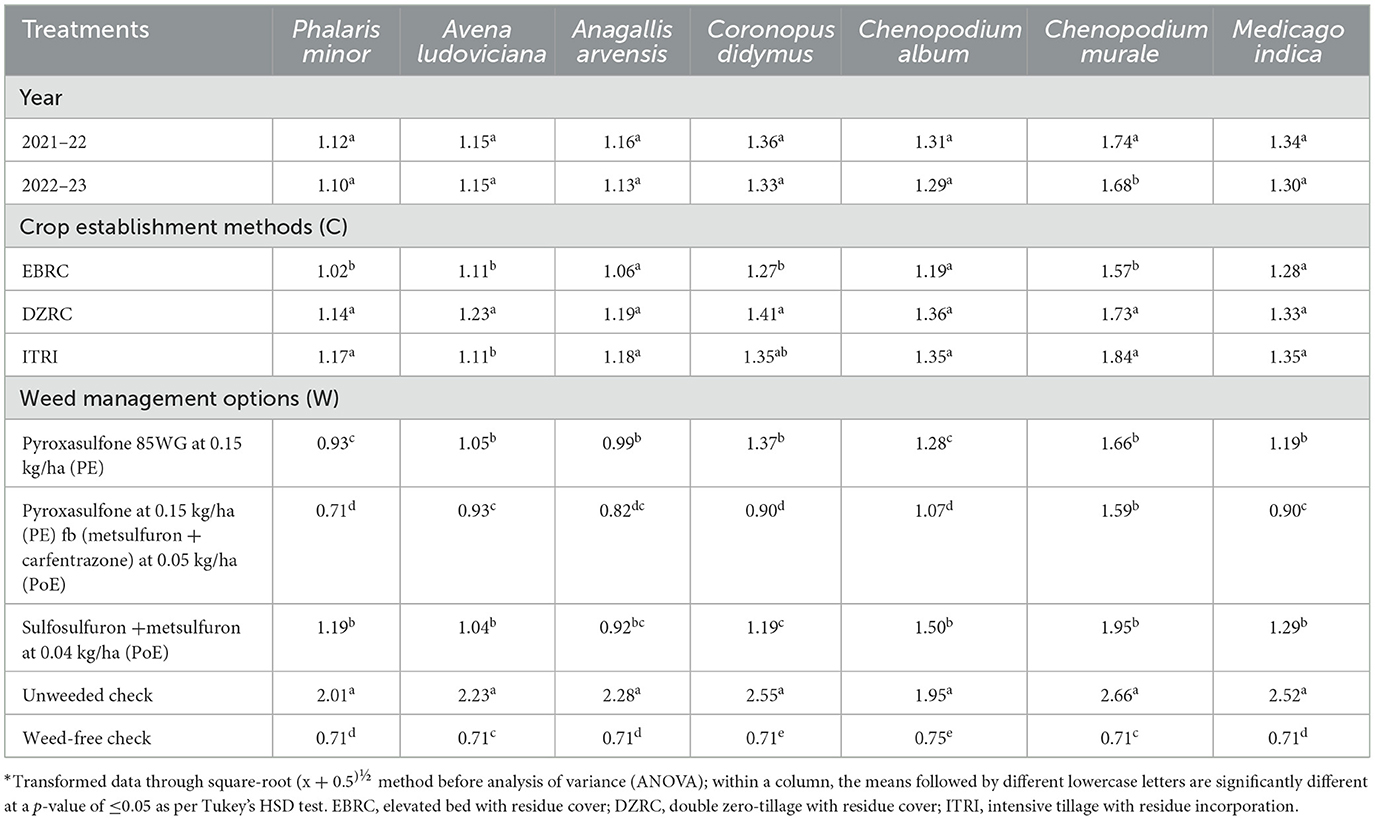
Table 2. Species-wise density of weeds as influenced by crop establishment methods and weed management options (pooled data of 2 years) [data are square-root transformed (x + 0.5)1/2]*.
Across different crop establishment systems (Table 2), densities of Phalaris minor, Avena ludoviciana, and Coronopus didymus were 11.8, 10.8, and 11.0% lower under the elevated-bed system (EBRC) compared to double zero-tillage (DZRC), respectively. The densities of A. ludoviciana and Chenopodium album were statistically comparable between EBRC and conventional intensive tillage with residue incorporation (ITRI) treatments. No significant differences were noticed in the populations of Anagallis arvensis and Medicago indica across the crop establishment systems.
Among weed management options, the lowest populations of four dominant BLW species, namely, C. didymus, C. album, C. murale, and M. indica, were recorded under treatment WFC, followed by Pyro-MetCarf, while the population densities of two major narrow-leaved weed species, namely, P. minor and A. ludoviciana, were 67.6% and 46.5% lesser in WFC compared to SulfoMet, respectively, although the differences between WFC and Pyro-MetCarf treatments were non-significant. Furthermore, the sequential application of Pyro-MetCarf consistently resulted in the lowest populations of P. minor, A. ludoviciana, C. didymus, C. album, C. murale, and M. indica, compared to standalone applications of Pyro or SulfoMet.
The category-wise weed density (Table 3) was significantly influenced by the year, crop establishment system, weed management options, and their interactions. In the second year of experimentation, the overall densities of NLWs (11.0 %), BLWs (3.4%), sedges (6.6%), and total weeds (6.1%) were significantly lower compared to the first year. Similarly, among the crop establishment systems, EBRC showed lower densities of BLWs (7.1%), sedges (11.5 %), and total weeds (10.9%) compared to DZRC. Contrarily, non-significant differences were observed in NLW population across the crop establishment systems. The Pyro-MetCarf treatment reduced the NLW, BLW, and sedges density by 178%, 143.2%, and 58% as compared to UWC, respectively. However, the best treatment was WFC, and it remained statistically superior to all other treatments. Notably, for controlling sedges population, Pyro alone and pyro-MetCarf were statistically at par. The Pyro-MetCarf treatment remained at par to WFC for controlling diverse weed flora.
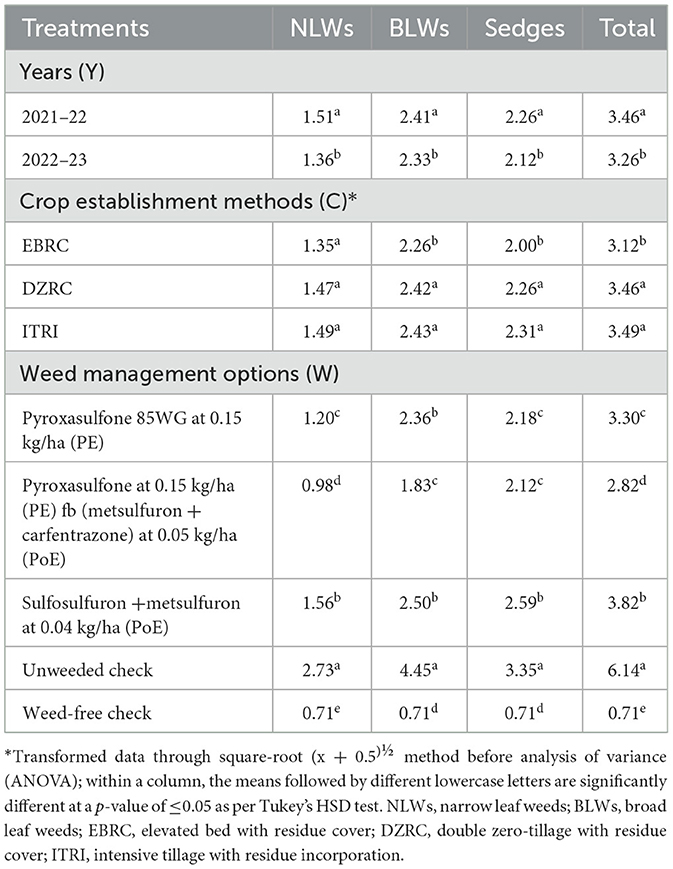
Table 3. Category-wise density of weeds as influenced by crop establishment methods and weed management options (pooled data of 2 years) at 40 DAS (number m−2)*.
For weed dry matter (Table 4), no significant differences were observed due to the years and crop establishment systems. However, numerically, the lowest total weed dry matter and dry matter of NLWs, BLWs, and sedges were recorded in the EBRC, compared to DZRC and ITRI. The weed-free check (WFC) exhibited the lowest dry matter accumulation (Tables 3, 4) among all treatments. Dual-stage spray treatment of Pyro-MetCarf resulted in the lowest dry matter of NLWs, BLWs, sedges, and total weeds, outperforming other herbicidal treatments. However, the WFC had resulted in lowest weed dry matter accumulation. The interaction effects for main plot × subplot (C × W), year × main plot (Y × C), and year × main plot × subplot (Y × C × W) were found to be non-significant.
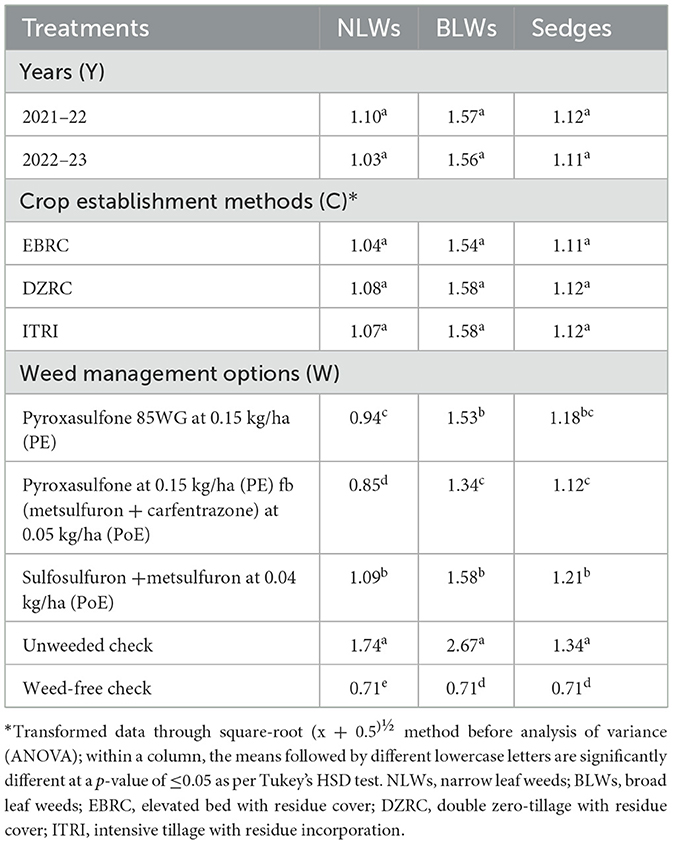
Table 4. Category-wise dry matter of weeds as influenced by crop establishment methods and weed management options (pooled data of 2 years) at 40 DAS (g m−2)*.
Both weed control efficiency (WCE; 66.3%) and weed control index (WCI; 67%) were significantly higher during the first year of experimentation compared to the second year (60.6 and 60.3%, respectively). However, no significant differences in WCE and WCI were observed among the various crop establishment systems (Table 5). Among weed management options, the WFC achieved the highest WCE and WCI. However, out of the herbicidal treatments, the application of Pyro-MetCarf resulted in significantly higher WCE (80.3%) and WCI (79.4%), followed by sole pre-emergence application of Pyro, which recorded 72.7% WCE and 71.9% WCI. The next best treatment was SulfoMet, with WCE and WCI values of 64.3% and 66.95%, respectively.
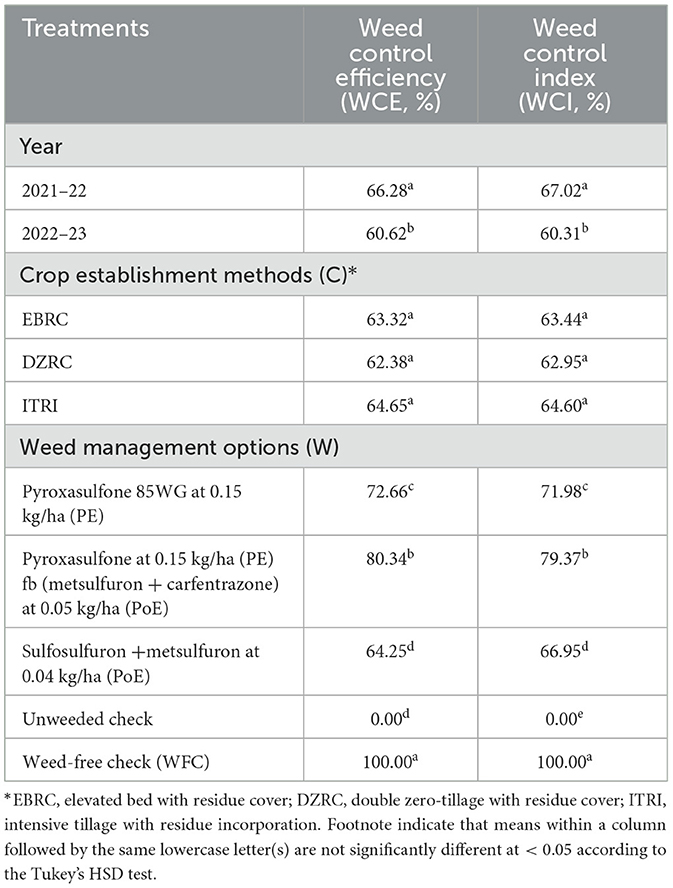
Table 5. Weed control efficiency and weed control index as influenced by crop establishment methods and weed management options (pooled data of 2 years) at 40 DAS.
3.2 Species diversity GGE biplot analysis
To have greater insights in interactive effects, four patterns of GGE biplot viz. “which won where/what,” “mean vs. stability,” “ranking genotypes,” and “ranking environments” have been generated for weed density to identify best treatments, dominant weed species under specific treatments, average control of weed population, prevalent weed species, and best treatment combination for controlling weeds.
3.2.1 Which-won-where
Figure 2a depicts the which-won-where view of different population of weeds under various treatments. The total variation of 88.87% was captured by both principal components (PC) accounting 59.38% and 29.49% by PC1 and PC2, respectively. The polygon was divided into five sectors by six rays forming two major mega environments. The populations of P. minor, R. dentatus, A. arvensis, and C. didymus were in the vertices of each sectors indicating highest population in their distinctive mega-environment. The population of P. minor was not favored under any of the mega-environments and was in a different sector indicating distinctive performance irrespective of the environment (year × treatment). C. album was more favored under M3S3 treatment combination, whereas M3S3 situated farther from origin thus indicating higher discriminating ability. R. dentatus was more favored under M1S1, M1S2, M1S3, M2S1, M2S2, M2S3, and M3S2 treatment combinations. The population of C. didymus and M. alba was favored by M1S4, M2S4, and M3S4 combinations. The weeds were not favored by environments M1S5, M2S5, and M3S5 being situated at the origin.
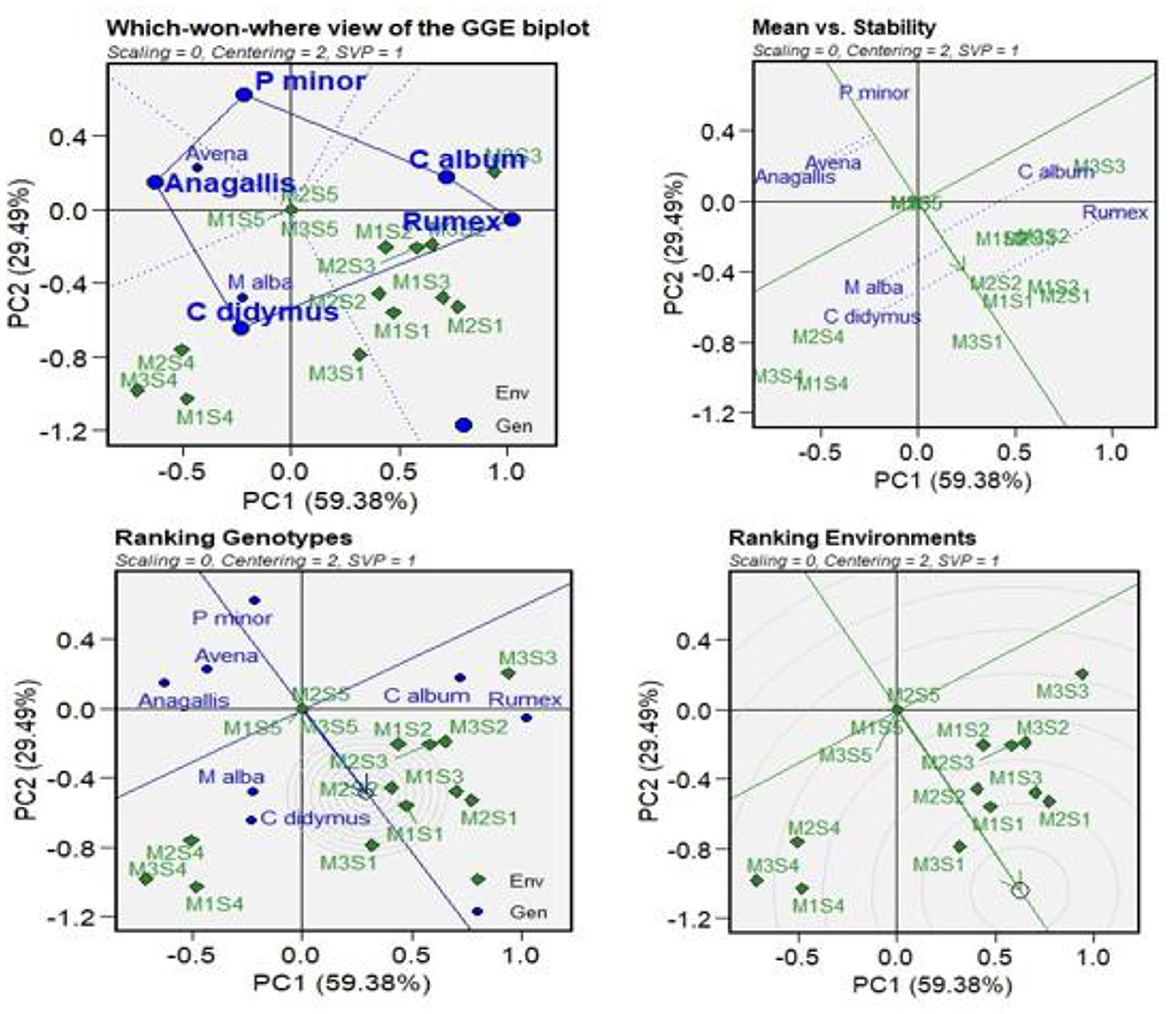
Figure 2. Species-wise GGE biplot analysis of weed population in wheat: (a) Which-won-where view of the GGE biplot; (b) Mean vs. Stability; (c) Ranking genotypes; (d) Ranking environments. Species-wise GGE biplot analysis of weed population in wheat.
3.2.2 Mean vs. stability
Figure 2b represents the mean performance of weed population across different treatments and stability among the weeds. It was observed that higher than the average population of weeds was recorded for R. dentatus, C. album, and P. minor with R. dentatus being situated at right side, whereas A. ludoviciana, A. arvensis, M. alba, and C. didymus were recorded lower population than average. Furthermore, P. minor recorded higher stability in terms of population across all the treatments indicated by lowest projection from AEC, indicating its more frequent presence in all the treatment combinations. A. ludoviciana and A. arvensis recorded lower population than the average population and also similar in stability in population under all treatments.
3.2.3 Ranking genotypes
No genotypes (here species) were observed within the concentric circle indicating the treatments significantly reduced the population of all weed species. P. minor being situated farthest from the concentric circle indicating lowest population (Figure 2c). The genotypes can be ranked in descending order as R. dentatus >C. didymus> M. alba > C. album > A. ludoviciana > A. arvensis > P. minor.
3.2.4 Ranking environments
M3S1 treatment combination (Figure 2d) was closest to the concentric circles signifying highest population of weeds followed by M1S1 and M2S1. The environments, namely, M1S5, M2S5, and M3S5, were clustered together and farthest from concentric circle implying similar reduction in weed population and lowest weed population was recorded. The environments can be ranked in descending order as M3S1> M1S1 > M2S1 > M1S3 > M2S2> M2S3= M3S2 > M1S2 > M1S4 > M2S4 > M3S3 >M3S4 > M1S5= M2S5 = M3S5.
3.3 Wheat growth and yield
Across the 2-year data, non-significant differences were observed in leaf area index (LAI), dry matter accumulation (DMA) (Table 6), tiller count per meter row length (Table 7), crop growth rate (CGR) (Figure 3), relative growth rate (RGR) (mg g−1 m−2) (Figure 4), net assimilation rate (NAR) (Figure 5), ear length (cm), and the number of seeds per ear (Table 8) across crop establishment methods and weed management options as well during the experimentation period. There were no significant variations in LAI at 40 DAS, DMA at 40, 80, and 120 DAS (Table 6), tiller count per meter row length at 40, 80, and 120 DAS (Table 7), CGR (Figure 3), RGR (mg g−1 m−2) (Figure 4), and NAR (Figure 5) among the crop establishment systems. However, LAI values at 80 DAS (4.47) and 120 DAS (3.01) were significantly higher under the EBRC compared to DZRC. These LAI values for EBRC were statistically on par with those observed under ITRI. This indicates that the EBRC provided a favorable environment for enhanced crop growth during later growth stages.
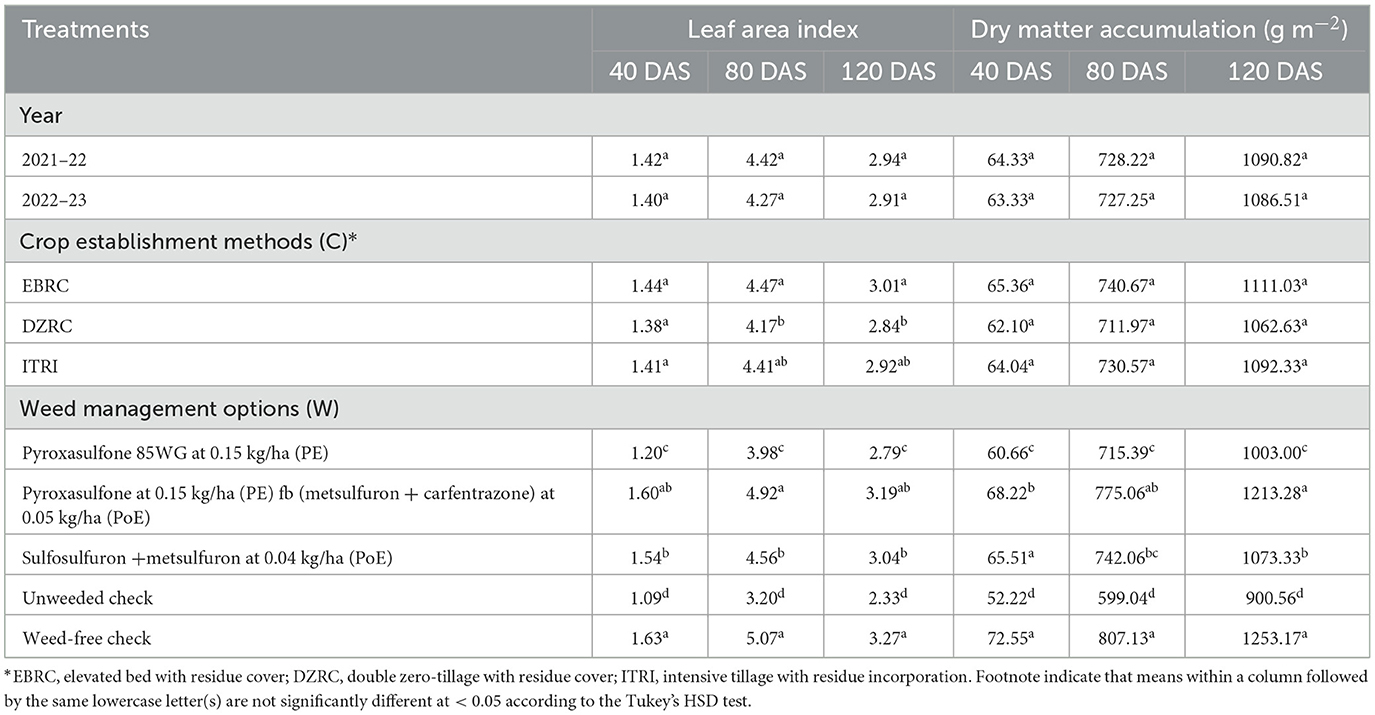
Table 6. Leaf area index and dry matter accumulation of wheat as influenced by crop establishment methods and weed management options (pooled data of 2 years).
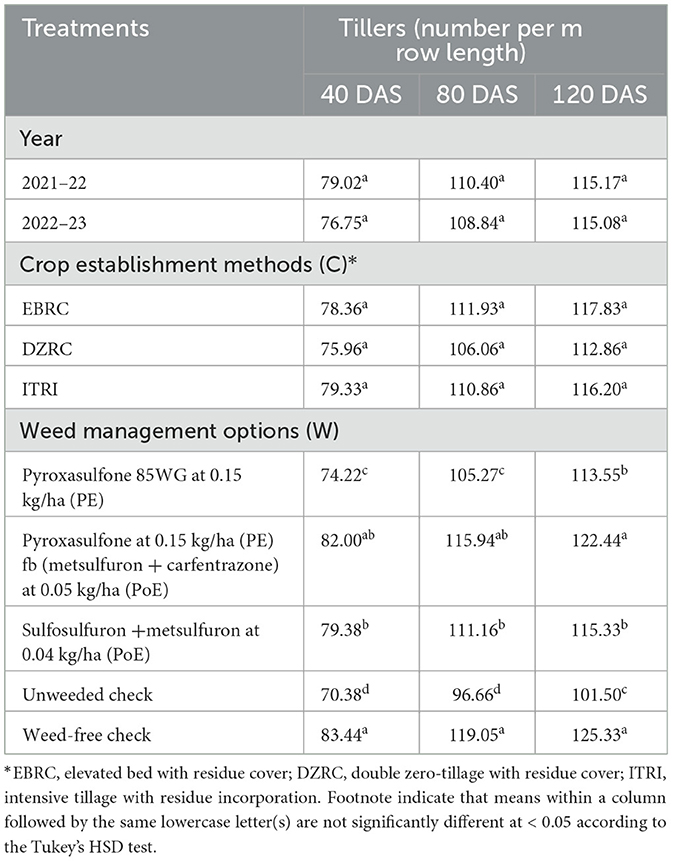
Table 7. Number of tillers per meter row length as influenced by crop establishment methods and weed management options (pooled data of 2 years).
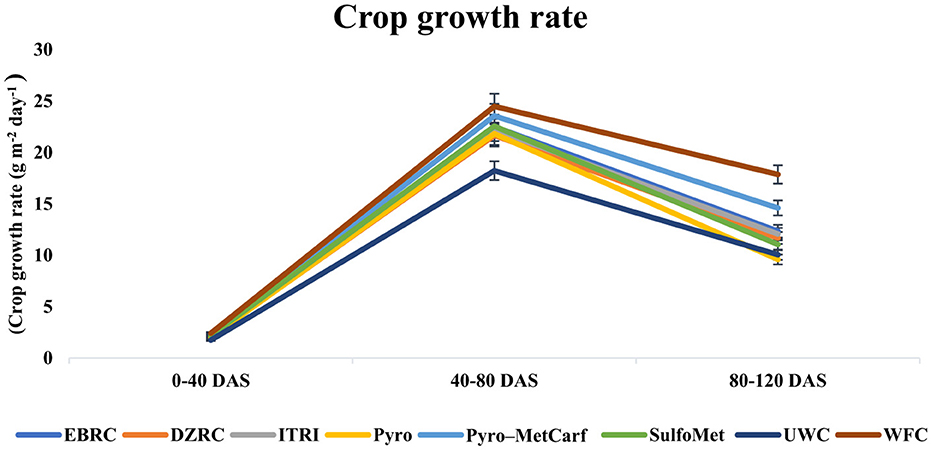
Figure 3. Effect of crop establishment methods and weed management options on crop growth rate of wheat (pooled mean). EBRC, elevated bed with residue cover; DZRC, double zero-tillage with residue cover; ITRI, intensive tillage with residue incorporation.
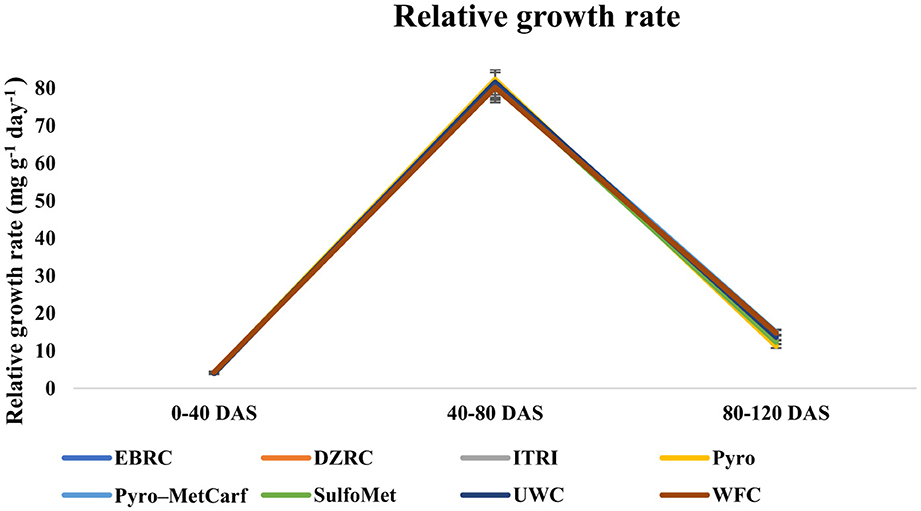
Figure 4. Effect of crop establishment methods and weed management options on relative growth rate of wheat (pooled mean). EBRC, elevated bed with residue cover; DZRC, double zero-tillage with residue cover; ITRI, intensive tillage with residue incorporation.
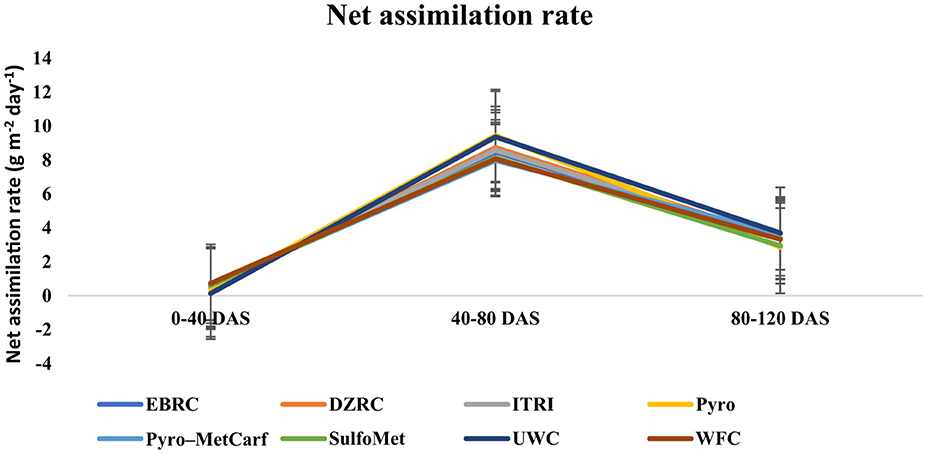
Figure 5. Effect of crop establishment methods and weed management options on net assimilation rate of wheat (pooled mean). EBRC, elevated bed with residue cover; DZRC, double zero-tillage with residue cover; ITRI, intensive tillage with residue incorporation.
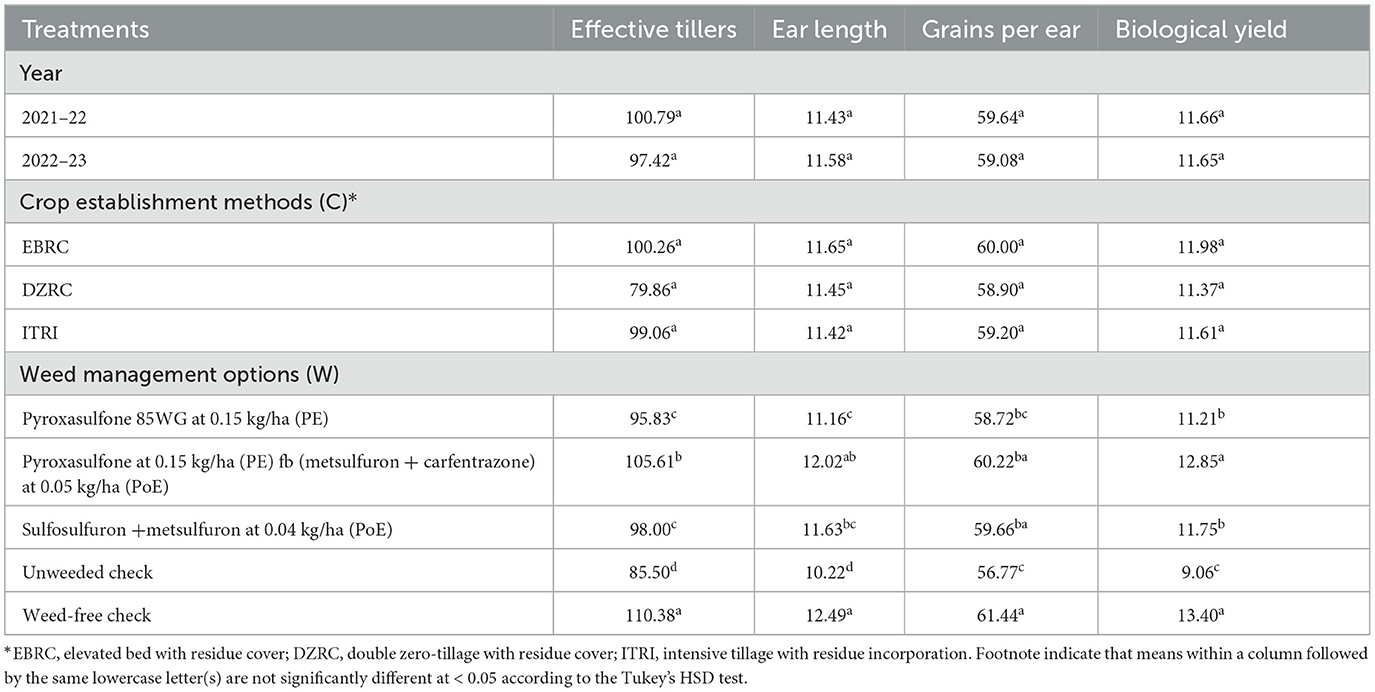
Table 8. Yield parameter of wheat influenced by crop establishment methods and weed management options (pooled data of 2 years).
Among the weed management options, the weed-free check (WFC) consistently recorded the highest values for LAI (1.63, 5.07, and 3.27), DMA (72.5, 807.0, and 1253.2 g m−2), and tiller count (83.4, 119.0, and 125.3 per meter row length) at 40, 80, and 120 DAS, respectively, compared to all herbicidal treatments studied. The treatment where co-application of herbicides has been done (Pyro–MetCarf) demonstrated significantly higher LAI (1.60, 4.92, and 3.19), DMA (68.2, 775.1, and 1213.3 g m−2), and tiller counts (82.0, 115.9, and 112.4 m−1 row length) at 40, 80, and 120 DAS, respectively. Furthermore, this treatment recorded 53.8% higher LAI, 29.4 5% higher dry matter, and 19.9% more number of tillers compared to UWC after 80 DAS. During the early growth stage (0–40 DAS), the highest crop growth rate (CGR), relative growth rate (RGR), and net assimilation rate (NAR) were observed under the WFC (2.41 g m−2 day−1, 4.28 mg g−1 day−1, and 0.72 g m−2 day−1, respectively), followed closely by Pyro–MetCarf application (2.27 g m−2 day−1, 4.18 mg g−1 day−1, and 0.66 g m−2 day−1, respectively). Non-significant differences were seen at later stages of crop growth (40–80 DAS and 80–120 DAS) in RGR and NAR. At later growth stages (80 and 120 DAS), wheat plants approach maturity with reduced vegetative growth and biomass accumulation, leading to stabilization of RGR and NAR values. Moreover, canopy closure and uniform environmental conditions minimize treatment effects, resulting in non-significant differences among herbicide treatments.
However, CGR was significantly higher under Pyro–MetCarf and the weed-free check (WFC) during these periods, highlighting the superior weed suppression and crop growth benefits of these treatments.
The number of effective tillers, ear length, and the number of grains per ear of wheat were not affected significantly due to temporal variations (year effects) or crop establishment systems as well. However, imposed weed management practices had a significant impact on all yield attributes (number of effective tillers, ear length, and number of grains per ear, Table 7). The weed-free check (WFC) recorded the highest values for yield parameters, including number of effective tillers (110.38), ear length (12.49 cm), and number of grains per ear (61.44). In contrast, the lowest values for these attributes were observed in the UWC, which were 22.1, 18.2, and 7.6% lower than WFC in number of effective tillers, ear length, and number of grains per ear, respectively. Dual-stage application of Pyro-MetCarf significantly enhanced yield attributes, recording 105.6 effective tillers per meter row length, 12.0 cm ear length, and 60.2 number of grains per ear. These values were statistically comparable to those achieved under the WFC, indicating the efficacy of Pyro-MetCarf in optimizing wheat yield attributes through effective weed control.
The differences in wheat biological yield were not reached to significant levels because of temporal variations and different crop establishment methods studied as demonstrated by a pooled analysis of 2-year data (Table 8). Among the crop establishment systems, EBRC produced the highest grain yield (5.55 t ha−1), followed by ITRI at 5.45 t ha−1, and DZRC at 5.29 t ha−1 (Figure 6). The treatment WFC recorded the highest grain yield (6.27 t ha−1), while the UWC obtained the lowest crop yield (4.37 t ha−1). Among the sequential herbicide treatments, Pyro-MetCarf recorded the highest grain yield (5.77 t ha−1). Over the 2 years, Pyro-MetCarf resulted in a mean grain yield increase of 24.3% compared to the UWC, highlighting its effectiveness in improving yield through better weed control efficacy.
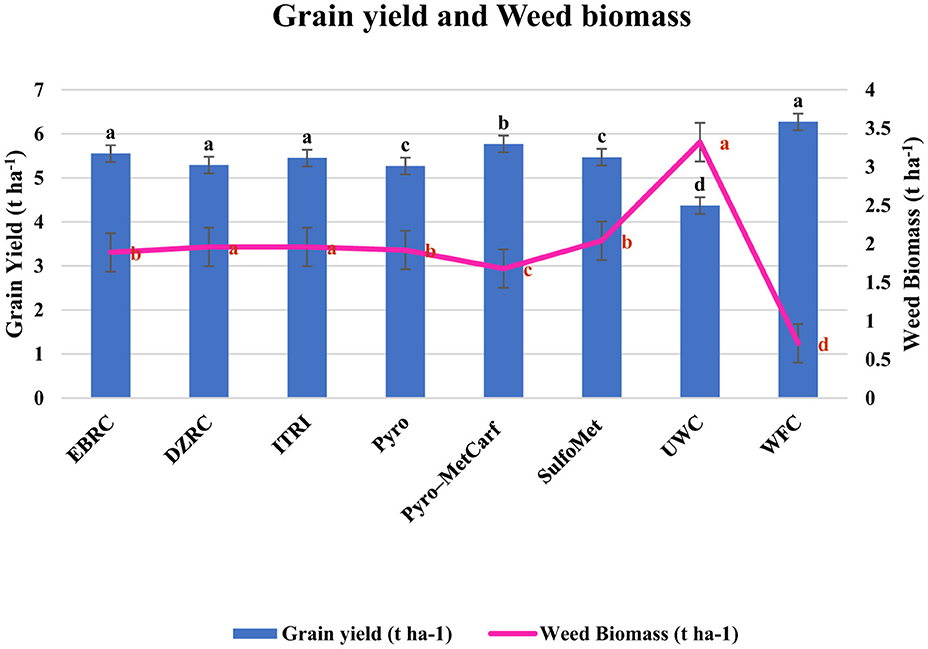
Figure 6. Effect of crop establishment methods and weed management options on wheat grain yield (t ha−1) and dry weed biomass (t ha−1) at 40 DAS (pooled mean). EBRC, elevated bed with residue cover; DZRC, double zero-tillage with residue cover; ITRI, intensive tillage with residue incorporation.
The weed index (WI), which reflects the percentage reduction in crop yield due to crop-weed competition, showed that the highest yield loss (30.3%) occurred in the UWC, underscoring the substantial negative impact of uncontrolled weed growth on crop productivity. The WFC served as the standard control in which no weed growth was permitted, thereby representing an ideal weed-free environment where crop yield was not affected by weed interference (Figure 7). Among the sequential herbicide treatments, the lowest weed index (8.02%) was recorded with Pyro-MetCarf, closely followed by SulfoMet at 12.7%. The highest weed index among herbicide treatments was observed with Pyro alone (15.9%), suggesting that while it provided some degree of weed suppression, it was less effective than the sequential applications. These findings highlight the critical role of integrated weed management, particularly the use of sequential herbicides such as Pyro-MetCarf in minimizing yield losses caused by weed competition.

Figure 7. Effect of crop establishment methods and weed management options on weed index (% reduction of wheat yield due to weeds) (pooled of 2 years).
4 Discussion
4.1 Weed dynamics
Crop establishment methods had a pronounced impact, resulting in significantly higher density and dry weight of narrow-leaved weeds (NLWs), broad-leaved weeds (BLWs), sedges, and total weed populations in the first year of experimentation compared to the second year. This trend can be attributed to favorable environmental conditions in the first year, particularly optimal precipitation, promoting multiple flushes of weed seed germination during the wheat-growing period (Figure 1). In contrast, the retention of crop residues as mulch proved highly effective in reducing weed density and dry matter accumulation. Maize residues applied on the soil surface functioned as a physical barrier, restrictin g light penetration to the soil, thereby suppressing weed germination and growth of numerous weed species infesting the wheat crop (Sharma et al., 2023). In addition, the residue covers likely induced physico-chemical and biological changes in the soil environment, further suppressing weed seed germination and emergence (Teasdale, 2000; Jabran and Chauhan, 2015).
The EBRC remained significantly more effective in reducing the densities of NLWs, BLWs, sedges, and total weeds compared to DZRC and ITRI systems (Sharma et al., 2023; Kumar and Kaur, 2024). The EBRC enhanced wheat growth by improving root density, increasing dry matter accumulation, and promoting a greater number of tillers (Kumar et al., 2023). These improvements facilitated better nutrient acquisition throughout the growing season. The higher tiller count in wheat strengthened its competitive ability, effectively suppressing weed growth on raised beds compared to flatbed systems, irrespective of the tillage method employed (Kumar and Kaur, 2024).
The influence of tillage on the weed seed bank remains a topic of ongoing debate. Some studies have reported negligible effects of tillage on increasing (Barberi et al., 2001) or decreasing (Murphy et al., 2006) weed seed bank density. Tillage practices affect the redistribution of weed seeds across the soil profile (0–30 cm) in varying ways. For instance, conventional tillage (CT) evenly distributes weed seeds within the plow zone, while zero tillage (ZT) results in accumulation of 60–90% of weed seeds in the top 0–5 cm of the soil (Hoffman et al., 1998). During the initial period from conventional to CA and no-tillage systems, the germinable weed seed bank tended to increase temporarily. However, later, no-tillage practices led to a significant reduction in weed seed bank density, by ~45–75%, compared to CT (Sergeja et al., 2024).
In addition, the dual-stage application of Pyro-MetCarf demonstrated remarkable efficacy in reducing weed densities. Over 2 years, this treatment achieved significant reductions in the densities of NLWs (64.1%), BLWs (58.9%), and sedges (41.2%) compared to the unweeded check.
Pyroxasulfone proved highly effective in controlling early-emerging NLWs, BLWs, and sedges by targeting them at the germination stage. This pre-emergence herbicide, characterized by its pyridine and oxazole rings, inhibits the biosynthesis of very-long-chain fatty acids, thereby arresting weed growth. On the other hand, the post-emergence combination of Met+Carf effectively controlled later-emerging NLWs and BLWs. A similar pattern was observed in the reduction of weed dry matter across NLWs, BLWs, and sedges. Higher WCE was recorded in elevated beds and intensive tillage with residue retention due to a lower weed density (Kaur et al., 2019; Kumar et al., 2022). Conversely, DZRC exhibited lower WCE and WCI, primarily due to the accumulation of a larger weed seed bank in the upper soil layer and the absence of soil disturbance in ZT practices.
The sequential application of Pyro-MetCarf demonstrated the highest WCE and WCI. This superior performance can be attributed to its ability to significantly reduce both the density and dry matter accumulation by weeds, ensuring balanced and sustained weed control throughout the crop growth period.
The GGE biplot analysis of weed population under different main plot and subplot combination revealed that R. dentatus was not controlled effectively by the combination of EBRC and DZRC along with varied herbicide application, whereas C. didymus and M. alba were controlled by these treatments when compared to UWC. This might have been due to shifting of weed flora from grassy weeds to more resistant R. dentatus along resistance to tolerate even higher dose of some herbicides (Chhokar et al., 2022). Furthermore, the population of P. minor was lowest implying effective control by different treatment combinations. The lowest population of P. minor might be owing to the inhibition of light penetration for germination and growth of weeds with residue retention combined with effectiveness of various herbicides (Ghosh et al., 2022a,b; Kaur and Singh, 2019). Herbicide resistance in R. dentatus and other broad-leaved weeds has been linked with increased metabolic resistance and altered translocation, as in case of P. minor for isoproturon resistance (Chhokar et al., 2022). Moreover, repeated use of single-site herbicides such as pyroxasulfone may select for cross-resistance in multiple weed species, necessitating integrated weed management strategies involving herbicide rotation and mixtures (Kaur and Singh, 2019). A. ludoviciana and A. arvensis were recorded similar mean population along with stability indicating the identical effectiveness of treatment combinations in controlling the population of these two weeds. Ranking of the environments analysis revealed ITRI in combination with sulfoMet was most effective treatment in controlling weed population significantly followed by DZRC and EBRC. The combination of ITRI and pyroxasulfone was inferior in controlling weed population indicating higher population of weeds. Relatively higher population of weeds might be attributed to lower control of some broad-leaved weeds by application of pyroxasulfone alone which otherwise could be effectively controlled by a combination of both pre- and post-emergence herbicides (Kaur and Singh, 2019; Samota et al., 2024).
4.2 Growth parameters, yield attributes, and yield
During the second year of experimentation, a significant decline in yield was noticed. The unexpected rainfall at the grain-filling stage of wheat resulted in significant crop lodging and subsequent yield reductions. However, wheat cultivated on elevated beds demonstrated resilience to lodging and achieved higher yields. This advantage was attributed to better root proliferation, reduced weed density, and a more favorable microclimate that supported better crop growth under EBRC. Furthermore, the EBRC system significantly minimized the competition for critical resources, including space, light, nutrients, and moisture, and also benefitted from the weed-suppressive effects of maize residue retention (Raj et al., 2022; Kaur et al., 2024a). The maize residue cover acted as a physical barrier, which effectively suppressed weed germination and growth by limiting light penetration and altering soil microclimatic conditions (Bana et al., 2020). In addition, the retained residue improved soil health by enhancing moisture retention, moderating temperature fluctuations, and fostering beneficial microbial activity (Bana et al., 2023b).
These improvements allowed the wheat crop to establish better anchorage and deeper root systems, which facilitated enhanced nutrient and moisture acquisition. This, in turn, supported efficient photosynthesis, leading to increased leaf area, greater dry matter accumulation, and vigorous vegetative growth across the crop canopy (Duan et al., 2024). Moreover, the reduction in weed density and dry matter minimized competition for critical resources, such as water, nutrients, and space, while improving soil aeration in the EBRC system (Mondal et al., 2020). This favorable environment created ideal atmosphere for robust crop development, resulting in higher number of tillers, longer ear length, and an increased number of grains per ear (Table 8). These findings are in the line with the studies from Ghosh et al. (2022a), Sharma et al. (2023), and Kaur et al. (2024b), which emphasize the advantages of raised bed planting systems in enhancing wheat growth and productivity. Collectively, these factors underscore the superiority of the EBRC method in mitigating yield losses under adverse weather scenarios, such as rainfall-induced lodging, and in promoting higher and more sustainable wheat yields through improved weed suppression, resource use efficiency, and crop growth performance (Ghosh et al., 2022b).
Among the weed management strategies tested, the dual-stage application of Pyro-MetCarf emerged as the most effective option for controlling a wide spectrum of weed flora. This treatment provided a weed-free environment during the critical period of crop-weed interference, a key factor in minimizing yield losses and optimizing crop growth (Ghosh et al., 2022b; Kumar et al., 2022). The comprehensive weed suppression achieved through the sequential herbicide application not only minimized competition for vital resources but also created season-long idealistic environment for wheat growth, ultimately resulting in higher grain yields.
Despite these advancements in weed control, no significant differences in grain yield were observed across the various crop establishment systems within the short duration of the experiment. This lack of variation could be attributed to the limited time frame of the study as changes in soil health and productivity often require a longer period to manifest. The physical and biological properties of soil, including soil structure, microbial activity, and nutrient availability, evolve gradually over time (Kumar et al., 2023). Moreover, the accumulation of soil organic carbon, which is vital for sustaining long-term soil fertility and crop productivity, may take several years of consistent management practices to reach levels that significantly influence yields (Bana et al., 2023a). It is plausible that sustained experimentation over 4–5 years or more would reveal significant differences in grain yield among the crop establishment systems (Bana et al., 2020, 2023b). Continuous implementation of practices such as residue retention, elevated bed planting, or no-tillage could progressively enhance soil properties, improve water-use efficiency, and build resilience against biotic and abiotic stresses, ultimately contributing to sustainable and higher crop yields (Govaerts et al., 2007).
5 Conclusion
In the maize–wheat cropping system of the Indo-Gangetic Plains, integrating elevated-bed planting with residue retention and sequential herbicide applications, pyroxasulfone as pre-emergence followed by tank mix application of metsulfuron methyl + carfentrazone as post-emergence application (Pyro–MetCarf) have proven highly effective in managing narrow-leaved weeds (NLWs), broad-leaved weeds (BLWs), and sedges. This combined approach not only enhances weed control efficiency and the weed control index but also improves wheat growth and yield attributes. The dual-stage herbicide application effectively targets both early and late-emerging weed species, ensuring comprehensive weed management throughout the cropping season. In addition, the retention of maize residues as mulch suppresses weed germination and growth, further contributing to a healthier wheat crop, in addition to its moisture saving effects. Therefore, it can be concluded that bed planting + residue along with sequential application of herbicides, Pyro–MetCarf, provides better control of weeds and leads to higher yield of wheat crop in Indo-Gangetic Plains of India. Further research is warranted to refine the broad-spectrum sequential herbicide-based integrated weed management strategy by assessing their long-term effects on weed seed-bank dynamics, herbicide resistance development, soil health, and system productivity under diverse agro-climatic conditions.
Data availability statement
The original contributions presented in the study are included in the article/Supplementary material, further inquiries can be directed to the corresponding authors.
Author contributions
SK: Writing – original draft, Data curation, Conceptualization, Supervision, Validation, Investigation. RK: Resources, Writing – original draft, Investigation, Project administration, Validation, Funding acquisition, Conceptualization, Supervision, Writing – review & editing. RB: Visualization, Formal analysis, Validation, Writing – review & editing, Writing – original draft, Conceptualization. TJ: Data curation, Software, Writing – original draft. SM: Writing – review & editing, Funding acquisition, Resources, Project administration, Investigation. TS: Writing – review & editing, Visualization, Resources. SSa: Writing – original draft, Data curation, Methodology. SSe: Writing – review & editing, Conceptualization. SA: Formal analysis, Writing – original draft, Software, Resources. AD: Writing – review & editing, Supervision. TD: Project administration, Writing – review & editing.
Funding
The author(s) declare that no financial support was received for the research and/or publication of this article.
Acknowledgments
The authors gratefully acknowledge the Division of Agronomy, ICAR-Indian Agricultural Research Institute, New Delhi, for providing the essential facilities and support that enabled the successful completion of this study.
Conflict of interest
The authors declare that the research was conducted in the absence of any commercial or financial relationships that could be construed as a potential conflict of interest.
Generative AI statement
The author(s) declare that no Gen AI was used in the creation of this manuscript.
Publisher's note
All claims expressed in this article are solely those of the authors and do not necessarily represent those of their affiliated organizations, or those of the publisher, the editors and the reviewers. Any product that may be evaluated in this article, or claim that may be made by its manufacturer, is not guaranteed or endorsed by the publisher.
Supplementary material
The Supplementary Material for this article can be found online at: https://www.frontiersin.org/articles/10.3389/fsufs.2025.1624283/full#supplementary-material
References
Annual Report (2023-24). Department of Farmer Agriculture and Farmer Welfare GOI, Available online at: https://agriwelfare.gov.in/Documents/AR_English_2023_24.pdf
Baghel, J. K., Das, T. K., Pankaj, M.ukherjee, I., Nath, C. P., Bhattacharyya, R., Ghosh, S., et al. (2020). Impacts of conservation agriculture and herbicides on weeds, nematodes, herbicide residue and productivity in direct-seeded rice. Soil Till. Res. 201, 104–111. doi: 10.1016/j.still.2020.104634
Bana, R. S., Bamboriya, S. D., Kumar, V., Godara, S., Gaydon, D. S., Laing, A. M., et al. (2023a). Identifying optimum residue levels for stable crop and water productivity and carbon sequestration under a conservation agriculture-based rice-wheat system. Soil Till. Res. 232:105745. doi: 10.1016/j.still.2023.105745
Bana, R. S., Grover, M., Singh, D., Bamboriya, S. D., Godara, S., Kumar, M., et al. (2023b). Enhanced pearl millet yield stability, water use efficiency and soil microbial activity using superabsorbent polymers and crop residue recycling across diverse ecologies. Eur. J. Agron. 148:126876. doi: 10.1016/j.eja.2023.126876
Bana, R. S., Pooniya, V., Choudhary, A. K., and Rana, K. S. (2014). Agronomic Interventions for Sustainability of Major Cropping Systems of India. New Delhi: Indian Agricultural Research Institute, 34+vi.
Bana, R. S., Singh, D., Nain, M. S., Kumar, H., Kumar, V., and Sepat, S. (2020). Weed control and rice yield stability studies across diverse tillage and crop establishment systems under on-farm environments. Soil Till. Res. 204:104729. doi: 10.1016/j.still.2020.104729
Barberi, P., Bonari, E., and Mazzoncini, M. (2001). Weed density and composition in winter wheat as influenced by tillage systems, 451–455. Available online at: https://www.cabdirect.org/cabdirect/abstract/20013179459
Bhattacharyya, R., Das, T. K., Sudhishri, S., Dudwal, B., Sharma, A. R., Bhatia, A., et al. (2015). Conservation agriculture effects on soil organic carbon accumulation and crop productivity under a rice–wheat cropping system in the western Indo-Gangetic Plains. Eur. J. Agron. 70, 11–21. doi: 10.1016/j.eja.2015.06.006
Blackman, V. H. (1919). The compound interest law and plant growth. Ann. Bot. 33, 353–360. doi: 10.1093/oxfordjournals.aob.a089727
Busari, M. A., Kukal, S. S., Kaur, A., Bhatt, R., and Dulazi, A. A. (2015). Conservation tillage impacts on soil, crop and the environment. Inter. Soil Water Conserv. Res. 3, 119–129. doi: 10.1016/j.iswcr.2015.05.002
Bystro, J. P., de Leon, N., and Tracy, W. F. (2012). Analysis of traits related to weed competitiveness in sweet corn (Zea mays L.). Sustainability 4, 543–560 doi: 10.3390/su4040543
CGIAR (2020). Available online at: https://repository.cimmyt.org/entities/publication/4ecb9832-43d-46e5-87fd-1a510179be73
Chhokar, R. S., Sharma, R. K., Chaudhary, A., and Singh, G. P. (2022). Herbicides for control of metsulfuron resistant toothed dock (Rumex dentatus). J. Res. Weed Sci. 5, 87–104.
Das, T. K. (2008). Weed Science: Basics and Applications, 1st Edn. New Delhi: Jain Brothers Publishers, 901.
Das, T. K., Bhattacharyya, R., Sudhishri, S., Sharma, A. R., Saharawat, Y. S., Bandyopadhyay, K. K., et al. (2014). Conservation agriculture in an irrigated cotton–wheat system of the western Indo-Gangetic Plains: crop and water productivity and economic profitability. Field Crops Res. 158, 24–33. doi: 10.1016/j.fcr.2013.12.017
Das, T. K., Nath, C. P., Das, S., Biswas, S., Bhattacharyya, R., Sudhishri, S., et al. (2020). Conservation agriculture in rice-mustard cropping system for five years: impacts on crop productivity, profitability, water-use efficiency, and soil properties. Field Crops Res. 250:107781. doi: 10.1016/j.fcr.2020.107781
Dhanda, S., Yadav, A., Yadav, D. B., and Chauhan, B. S. (2022). Emerging issues and potential opportunities in the rice–wheat cropping system of North-Western India. Front. Plant Sci. Sec. Crop Product Physiol. 13:832683. doi: 10.3389/fpls.2022.832683
Duan, M., Zhang, X., Wei, Z., Chen, X., and Zhang, B. (2024). Effect of maize canopy structure on light interception and radiation use efficiency at different canopy layers. Agronomy 14:1511. doi: 10.3390/agronomy14071511
Evans, S. P., Knezevic, S. Z., Lindquist, J. L., Shapiro, C. A., and Blankenship, E. E. (2003). Nitrogen application influence the critical period for weed control in corn. Weed Sci. 51, 408–417. doi: 10.1614/0043-1745(2003)051[0408:NAITCP]2.0.CO;2
FAO (2020). What is Conservation Agriculture? Available online at: http://www.fao.org/conservation-agriculture/overview/what-is-conservation-agriculture/en/ (Accessed April 24, 2020).
Ghosh, S., Das, T., Rana, K., Biswas, D., Das, D., Singh, G., et al. (2022b). Energy budgeting and carbon footprint of contrasting tillage and residue management scenarios in rice-wheat cropping system. Soil Till. Res. 223:105445. doi: 10.1016/j.still.2022.105445
Ghosh, S., Das, T., Shivay, S., and Bandyopadhyay, K. (2022a). Weed interference and wheat productivity in a conservation agriculture-based maize-wheat-mungbean system. J. Crop Weed. 18, 111–119 doi: 10.22271/09746315.2022.v18.i1.1540
Ghosh, S., Das, T. K., Sharma, D., and Gupta, K. (2019). Potential of conservation agriculture for ecosystem services: a review. Indian J. Agri. Sci. 89, 1572–1579. doi: 10.56093/ijas.v89i10.94578
Gill, H. S., and Vijaykumar. (1969). Weed index- a new method for reporting weed control trials. Indian J. Agron. 14, 96–98.
Govaerts, B., Sayre, K., Lichter, K., Dendooven, L., and Deckers, J. (2007). Influence of permanent raised bed planting and residue management on physical and chemical soil quality in rain fed maize/wheat systems. Plant Soil 291, 39–54. doi: 10.1007/s11104-006-9172-6
Hoffman, M. L., Owen, M. D., and Buhler, D. D. (1998). Effects of crop and weed management on density and vertical distribution of weed seeds in soil. Agron. J. 90, 793–799. doi: 10.2134/agronj1998.00021962009000060013xa
Jabran, K., and Chauhan, B. S. (2015). Weed management in aerobic rice systems. Crop Prot. 78, 151–163. doi: 10.1016/j.cropro.2015.09.005
Kaur, A., and Singh, S. (2019). Performance of different herbicides on wheat grain yield and correlation between growth and yield attributes of wheat and weeds. Indian J. Weed Sci. 51, 129–132. doi: 10.5958/0974-8164.2019.00029.7
Kaur, R., Kumar, S., Dass, A., Singh, T., Kumar, P., and Rakesh, D. (2023). Response of maize (Zea mays) to different planting methods with limited irrigation at water sensitive growth stages. Indian J. Agri. Sci. 93, 626–631. doi: 10.56093/ijas.v93i6.124163
Kaur, R., Kumar, S., Kumar, P., Dass, A., and Singh, T. (2024a). Synergistic effects of crop establishment methods and weed management on maize (Zea mays L.) productivity and water utilization. Maydica. 67, 1–7.
Kaur, R., Kumar, S., Meena, S. L., Dass, A., Bana, R. S., Singh, T., et al. (2024b). Effect of limited irrigation and planting systems on yield and water productivity of maize (Zea mays). Indian J. Agri. Sci. 94, 33–38. doi: 10.56093/ijas.v94i1.141903
Kaur, R., Raj, R., Das, T. K., Singh, R., Jaidka, M., and Shekhawat, M. (2020). Managing weeds using sequential herbicides in maize for improving crop growth and productivity under irrigated conditions in North-Western India. Maydica 65:11.
Kaur, S., Kaur, T., and Bhullar, M. S. (2017). Control of mixed weed flora in wheat with sequential application of pre- and post-emergence herbicides. Indian J. Weed Sci. 49, 29–32. doi: 10.5958/0974-8164.2017.00007.7
Kaur, T., Bhullar, M. S., and Kaur, S. (2019). Control of herbicide resistant Phalaris minor by pyroxasulfone in wheat. Indian J. Weed Sci. 51, 123–128. doi: 10.5958/0974-8164.2019.00028.5
Kumar, A., Pandey, D., Patel, J. R., Agrawal, H. P., Agrawal, A. P., Chaure, N. K., et al. (2022). Efficacy of herbicides against diverse weed flora of wheat (Triticum aestivum L.). J. Pharm. Innov. 11, 11–15. doi: 10.33545/26646552.2022.v4.i2a.37
Kumar, R., Naresh, R. K., Bhatt, R., Chandra, M. S., Kumar, D., Alamri, S., et al. (2023). Tillage crop establishment and irrigation methods improve the productivity of wheat (Triticum aestivum): water use studies, and the biological properties and fertility status of soil. Agronomy 13:1839. doi: 10.3390/agronomy13071839
Kumar, R. M., Yamanura, and Boraiah, B. (2021). Assessment of bioefficacy of novel pyroxasulfone for controlling weeds in summer maize. Indian J. Weed Sci. 53, 99–104. doi: 10.5958/0974-8164.2021.00017.4
Kumar, S., and Kaur, R. (2024). Controlling Phalaris minor with novel pyroxasulfone under conservation agriculture in the north-western Indo-Gangetic Plains. Indian J. Agri. Sci. 94, 74–79 doi: 10.56093/ijas.v94i1.143436
Kumar, S., Rana, S. S., and Chander, N. (2013). Herbicide combinations for broad-spectrum weed control in wheat. Indian J. Weed Sci. 45, 29–33.
Kumari, M., Chakraborty, D., Gathala, M. K., Pathak, H., Dwivedi, B. S., Tomar, R. K., et al. (2011). Soil aggregation and associated organic carbon fractions as affected by tillage in a rice–wheat rotation in North India. Soil Sci. Soc. Am. J. 75, 560–567. doi: 10.2136/sssaj2010.0185
Lal, R. (2015). Sequestering carbon and increasing productivity by conservation agriculture. J. Soil Water Conserv. 70, 55A–62A. doi: 10.2489/jswc.70.3.55A
Malik, R. K., and Yadav, A. (2008). “Direct-seeded rice in the Indo-Gangetic Plain: progress, problems and opportunities,” in Proceedings of Permanent Beds and Rice Residue Management for Rice-Wheat Systems in the Indo-Gangetic Plains. ACIAR Workshop Proceedings No. 127, eds. E. Humphreys and C. H. Roth (Canberra, ACT: ACIAR), 124–132.
McKenzie-Gopsill, A. G., Amirsadeghi, S., Fillmore, S., and Swanton, C. J. (2020). Duration of weed presence influences the recovery of photosynthetic efficiency and yield in common bean (Phaseolus vulgaris L.). Front. Agron. 2:593570. doi: 10.3389/fagro.2020.593570
Mehmeti, A., Pacanoski, Z., Fetahaj, R., Kika, A., and Kabashi, B. (2018). Weed control in wheat with post-emergence herbicides. Bulg. J. Agri. Sci. 24, 74–79.
Mondal, S., Chakraborty, D., Das, T. K., Shrivastava, M., Mishra, A. K., Bandyopadhyay, K. K., et al. (2019). Conservation agriculture had a strong impact on the sub-surface soil strength and root growth in wheat after a 7-year transition period. Soil Till. Res. 195:104385. doi: 10.1016/j.still.2019.104385
Mondal, S., Poonia, S. P., Mishra, J. S., Bhatt, B. P., Karnena, K. R., Saurabh, K., et al. (2020). Short-term (5 years) impact of conservation agriculture on soil physical properties and organic carbon in a rice-wheat rotation in the Indo-Gangetic plains of Bihar. Eur. J. Soil Sci. 71, 1076–1089. doi: 10.1111/ejss.12879
Mundra, S. L., Vyas, A. K., and Maliwal, P. L. (2002). Effect of weed and nutrient management on nutrient uptake by maize (Zea mays) and weeds. Indian J. Agron. 47, 378–383 doi: 10.59797/ija.v47i3.3176
Murphy, S. D., Clements, D. R., Belaoussoff, S., Kevan, P. G., and Swanton, C. J. (2006). Promotion of weed species diversity and reduction of weed seedbanks with conservation tillage and crop rotation. Weed Sci. 54, 69–77. doi: 10.1614/WS-04-125R1.1
Nazari, A. J., Amiri, H., Javadi, M., and Gohlami, M. (2013). Efficiency different herbicides appl. weed control wheat under rain fed conditions Iran. Int. J. Agri. Crop Sci. 5, 445–449.
Odero, D., and Wright, A. (2013). Response of sweet corn to pyroxasulfone in high-organic-matter soils. Weed Technol. 27, 341–346. doi: 10.1614/WT-D-12-00133.1
Page, K., Dang, Y., and Dalal, R. (2013). Impacts of conservation tillage on soil quality, including soil-borne crop diseases, with a focus on semi-arid grain cropping systems. Aust. Plant Path. 42, 363–377. doi: 10.1007/s13313-013-0198-y
Qi, J. Y., Han, S. W., Lin, B. J., Xiao, X. P., Jensen, J. L., Munkholm, L. J., et al. (2022). Improved soil structural stability under no-tillage is related to increased soil carbon in rice paddies: evidence from literature review and field experiment. Environ. Technol. Innov. 26:102248. doi: 10.1016/j.eti.2021.102248
Raj, R., Das, T. K., Ghosh, A., Govindasamy, P., Kumar, V., Babu, S., et al. (2022). Crop-establishment methods and weed management effects on weeds, wheat (Triticum aestivum) yield and economics under a conservation agriculture-based rice (Oryza sativa)–wheat system. Indian J. Agron. 67, 354–362. doi: 10.59797/ija.v67i4.138
Ramadas, S., Kumar, A., Singh, S., and Singh, G. P. (2019). “Wheat production technologies and food security: the nexus and prospects,” in Proceedings of PAJANCOA Conference 2019 (Karaikal: PAJANCOA).
Roper, M., Ward, P., Keulen, A., and Hill, J. (2013). Under no-tillage and stubble retention, soil water content and crop growth are poorly related to soil water repellence. Soil Till. Res. 126, 143–150. doi: 10.1016/j.still.2012.09.006
Samota, S. R., Chhokar, R. S., Yadav, D. B., Kumar, N., Gill, S. C., and Mamrutha, H. M. (2024). Pyroxasulfone based tank-mix herbicide combinations for diverse weed flora control in wheat. Crop Prot. 181:106695. doi: 10.1016/j.cropro.2024.106695
Sergeja, A. Z., Rovansek, A., and Leskovsek, R. (2024). Weed seed bank response during the early conversion period to less intensive tillage systems. Soil Till. Res. 242:106164. doi: 10.1016/j.still.2024.106164
Sharma, A. R. (2021). Conservation agriculture in India: history, progress and way forward. Indian J. Agron. 66, 1–18. doi: 10.59797/ija.v66i1.2824
Sharma, A. R., Jat, M. L., Saharawat, Y. S., Singh, V. P., and Singh, R. (2012). Conservation agriculture for improving productivity and resource-use efficiency: prospects and research needs in Indian context. Indian J. Agron. 57, 131–140.
Sharma, T., Das, T. K., Govindasamy, P., Raj, R., Sen, S., Roy, A., et al. (2023). Tillage, residue, and nitrogen management effects on weed interference, wheat growth, yield and nutrient uptake under conservation agriculture-based pigeonpea-wheat system. Indian J. Weed Sci. 55, 217–222 doi: 10.5958/0974-8164.2023.00040.0
Teasdale, J. R. (2000). The quantitative relationship between weed emergence and the physical properties of mulches. Weed Sci. 48, 385–392. doi: 10.1614/0043-1745(2000)048[0385:TQRBWE]2.0.CO;2
USDA (2024). World Agricultural Supply and Demand Estimates (WASDE). United States Department of Agriculture.
USDA, FAS. (2024). Available online at: https://ipad.fas.usda.gov/cropexplorer/cropview/commodityView.aspx?cropid=0410000
Venkatesh, M. S., Hazra, K. K., Ghosh, P. K., Khuswah, B. L., Ganeshamurthy, A. N., Ali, M., et al. (2017). Long–term effect of crop rotation and nutrient management on soil–plant nutrient cycling and nutrient budgeting in Indo–Gangetic Plains of India. Arch. Agron. Soil Sci. 63, 2007–2022. doi: 10.1080/03650340.2017.1320392
Watson, D. J. (1952). Comparative physiological studies in the growth of field crops. I. Variation in net assimilation rate and leaf area between species and varieties, and within and between years. Ann. Bot. 11, 41–76 doi: 10.1093/oxfordjournals.aob.a083148
Watson, D. J. (1958). The dependence of net assimilation on leaf area index. Ann. Bot. 22, 37–58. doi: 10.1093/oxfordjournals.aob.a083596
Yadav, G. S., Babu, S., Das, A., Bhowmik, S. N., Datta, M., and Singh, R. (2018). Soil carbon dynamics and productivity of rice–rice system under conservation tillage in submerged and unsubmerged ecologies of Eastern Indian Himalaya. Carbon Manag. 10, 51–62. doi: 10.1080/17583004.2018.1545518
Yan, W., and Kang, M. S. (2011). GGE Biplot Analysis: A Graphical Tool for Breeders, Geneticists, and Agronomists. Abingdon: Taylor & Francis Group.
Keywords: conservation agriculture, elevated bed planting, weed management, residue, zero tillage
Citation: Kumar S, Kaur R, Bana RS, Das TK, Jena T, Meena SL, Singh T, Sangwan S, Sepat S, Ali SA and Dass A (2025) Dual-stage herbicide regimen for tackling weed menace in wheat under multiple crop establishment systems. Front. Sustain. Food Syst. 9:1624283. doi: 10.3389/fsufs.2025.1624283
Received: 07 May 2025; Accepted: 10 July 2025;
Published: 30 July 2025.
Edited by:
Dinesh Jinger, Indian Institute of Soil and Water Conservation (ICAR), IndiaReviewed by:
Kailash Prajapat, Central Soil Salinity Research Institute (ICAR), IndiaDana Ram Palsaniya, ICAR Indian Grassland and Fodder Research Institute, Jhansi, India
Copyright © 2025 Kumar, Kaur, Bana, Das, Jena, Meena, Singh, Sangwan, Sepat, Ali and Dass. This is an open-access article distributed under the terms of the Creative Commons Attribution License (CC BY). The use, distribution or reproduction in other forums is permitted, provided the original author(s) and the copyright owner(s) are credited and that the original publication in this journal is cited, in accordance with accepted academic practice. No use, distribution or reproduction is permitted which does not comply with these terms.
*Correspondence: Ramanjit Kaur, cmFtYWFuMTgwMTAzQHlhaG9vLmNvbQ==; Ram S. Bana, cnNiYW5hQGdtYWlsLmNvbQ==
†Present Address: Sunil Kumar, Department of Agronomy, Post Graduate College of Agriculture, Dr Rajendra Prasad Central Agricultural University, Pusa, Bihar, India
‡ORCID: Sunil Kumar orcid.org/0009-0002-4192-2813
 Sunil Kumar
Sunil Kumar Ramanjit Kaur
Ramanjit Kaur Ram S. Bana
Ram S. Bana Tapas Kumar Das
Tapas Kumar Das Twinkle Jena
Twinkle Jena Samarth Lal Meena
Samarth Lal Meena Teekam Singh
Teekam Singh Seema Sangwan
Seema Sangwan Seema Sepat
Seema Sepat Sk Asraful Ali1
Sk Asraful Ali1 Anchal Dass
Anchal Dass